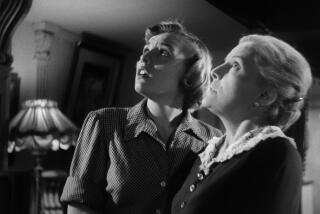Widow of Charles Laughton Had Many Talents : Actress Elsa Lanchester Dies at 84
- Share via
Actress Elsa Lanchester, a red-haired imp who failed to make it as a danseuse but succeeded in delighting audiences for 60 years with her bawdy cabaret songs and stage and film performances, died Friday at the Motion Picture and Television Hospital. She was 84 and her death was attributed to bronchial pneumonia.
The London-born entertainer had been in the Woodland Hills hospital since Dec. 17, after suffering a series of strokes. She had been comatose at home for several years before being admitted to the hospital.
The widow of Academy Award-winning actor Charles Laughton, she herself had been nominated for Oscars as best-supporting actress in “Come to the Stable” in 1949 and “Witness for the Prosecution” in 1957.
Array of Talents
She was so versatile she could horrify moviegoers as “The Bride of Frankenstein” (1935), enthrall drama devotees with a Shakespeare or Chekhov stage role and double-up cabaret patrons with her song-and-dance depiction of “Lola,” the naughty Spanish senorita.
Buffing her undulating hips with a shawl, Miss Lanchester would dance a fandango while relating in song how “somebody broke Lola’s saucepan.” Her audiences in such local theaters as the Turnabout on La Cienega Boulevard and the Ivar in Hollywood howled their appreciation.
Despite the acclaim Lanchester won for scores of movie and stage roles, her first love remained performing in music halls and cabarets. She gave more than 3,200 performances in the Turnabout alone in the 1940s and 1950s.
She boasted a repertoire of 50 or more British Victorian music-hall songs and comedy numbers especially tailored for her unique style by Forman Brown and other writer friends. She wailed them in Cockney.
“I always make my entrances at the Turnabout,” she once said, “looking as plain, even unattractive, as possible; nothing fancy or overdressed, no airs to make people say, ‘Oh, look at her! Just because she’s the wife of a star!’
Change in Costumes
“Later, I work in the prettier costumes and the flossier, more sophisticated songs, like ‘When a Lady Has a Piazza.’ By then everybody is in the spirit of the thing and willing to accept me, I hope, as myself.”
“When a Lady Has a Piazza” was her trademark number.
Miss Lanchester was born Elizabeth Sullivan in Lewisham, London, Oct. 28, 1902, and as a girl studied for three months at the famed Isadora Duncan’s School of Dance in Paris. But she had to return home when World War I broke out.
She never achieved her girlhood ambition of dazzling lovers of the classical dance with graceful movements “in a mist of gauze or chiffon.”
Instead, after teaching dance to children for several years, Miss Lanchester started collecting old music-hall songs while operating the Cave of Harmony cabaret in London in the 1920s.
Famous Friends
It was in this celebrated club that she entertained such friends and patrons as Evelyn Waugh, Christopher Isherwood and Osbert Sitwell with songs like “He Didn’t Oughter,” “The Ratcatcher’s Daughter” and “Won’t You Buy My Sweet Blooming Lavender?”
At the club, too, Lanchester claimed, she originated the costume of top hat, ballet tights and high heels later used by Marlene Dietrich.
In the club’s midnight show, she also presented dramatic readings, exotic dances and one-act plays. Aldous Huxley was so fascinated with the place that he featured it in his novel “Antic Hay.”
Whenever the American-born Lady Astor visited the club, she always asked Miss Lanchester to sing one of her ladyship’s favorite temperance songs, “Please Sell No More Drink to My Father.” And Miss Lanchester would obligingly screech:
Please, sir, will you listen a moment?
I’ve something important to say.
My mother has sent you a message,
Receive it in kindness, I pray.
‘Tis my father, poor father, I’m speaking;
You know him, he’s called Ragged Gore.
But we love him and hope we may save him,
If you promise to sell him no more.
Then, looking pitiful with a spit curl on her forehead and her hands raised in supplication, Lanchester would blast the chorus:
Please sell no more drink to my father;
It makes him so strange and so wild.
Heed the prayer of my heart-broken mother,
And pity the poor drunkard’s child!
Her friend Waugh, who became one of Britain’s finest writers, mentioned in his posthumously published “Diaries” a 1924 garret party he attended with her and her “set” of “pansies, prostitutes and journalists and struggling actors all quite drunk and in patches lusty.”
Miss Lanchester had her first roles on the legitimate stage at this time, too--in “Thirty Minutes in a Street” in 1922 and in Congreve’s “The Way of the World” in 1924.
It was also in 1924 that Miss Lanchester appeared with Waugh in a movie called “The Scarlet Woman.” It was a farce about a “popish plot” to forcibly convert England to Roman Catholicism. (Waugh himself became a Catholic six years later.)
Private Showings
Miss Lanchester appeared as a seductress in the film, which was shown a few times privately at Oxford University but never publicly. The film became a legend in Britain and the University of Texas now has one of only three existing prints.
Seemingly a big break came for the actress-singer in 1926, when she was hired to do a comic specialty number in the Midnight Follies at London’s Metropole. But disaster struck when a member of the British royal family walked out as she was singing “Please Sell No More Drink to My Father.” She was fired.
She shrugged off the matter and said later she should have used another song from her repertoire--”I Danced With a Man Who Danced With a Girl Who Danced With the Prince of Wales.”
However, Miss Lanchester got many other parts in many reviews. After appearing in a stage show, she would have to change costume in a taxicab while en route to the Cave of Harmony for the midnight show.
Role With Laughton
In 1927, she got a role opposite Charles Laughton in Arnold Bennett’s play, “Mr. Prohack.” They were married in 1929 after Miss Lanchester closed her Cave of Harmony cabaret. Without a liquor license, the club had never made much of a profit.
A year later Laughton was involved in a London police case involving a young man. Friends said she had no idea that her husband entertained homosexual predilections.
“Elsa could have burst into tears, collapsed or struck Charles,” Charles Higham wrote in his “Charles Laughton: An Intimate Biography,” which was published in 1976 with Miss Lanchester’s cooperation.
“But instead, her compassion fighting her despair, she simply said all she could in the circumstances: ‘It’s perfectly all right. It doesn’t matter. I understand.’ ”
They remained married for 32 years.
In 1928 Miss Lanchester had made her official movie debut in the silent British version of “The Constant Nymph.”
Nothing but Praise
When Laughton was cast in the title role in Alexander Korda’s “The Private Life of Henry VIII,” Miss Lanchester got to play the role of one of Henry’s wives, Anne of Cleves. This British movie earned Laughton the 1933 Academy Award, and Miss Lanchester, in her words, “paeans of praise, but few offers.”
Laughton had begun working in Hollywood in 1931, but it was not until 1935, after Miss Lanchester and her husband had done a number of plays for the Old Vic-Sadler’s Wells Company in London, that she got small character roles in Metro-Goldwyn-Mayer’s “David Copperfield” and “Naughty Marietta.”
Later in 1935, however, she came into her own as a movie actress when MGM lent her to Universal to star with Boris Karloff in “The Bride of Frankenstein.”
Miss Lanchester wrote in her 1938 autobiography, “Charles Laughton and I,” that she played “two very good parts” in this horror classic.
“In one role I was the female monster with a terrifying, sculptural sort of makeup, in the other I was Mary Shelley (the author of the “Frankenstein” novel) who was sweet and docile,” she wrote.
Basis of Complaint
But Miss Lanchester complained about the three hours of work it took to make up her face for the female monster.
“My hair stiffened into a Topsy-like mop and was to stick out backward on a little cage,” she said. “I was then bound in yards and yards of bandage, all most carefully done by a nurse.”
Although she made six successful movies with Laughton, Miss Lanchester said in a 1958 interview that she and her husband never considered themselves an acting “team.”
“We had separate acting careers when we first met, and separate we have kept them ever since,” she said. They appeared in the same movie or play “only when they happened to have roles that were right for both of us,” she added.
The movies in which they appeared together were the Henry VIII film, “Rembrandt” (1937), “The Beachcomber” (1937), “Tales of Manhattan” (1942), “The Big Clock” (1947) and “Witness for the Prosecution.”
Other of her better-known roles were in “The Ghost Goes West” (1936), “The Spiral Staircase” (1945), “The Inspector General” (1949), “Androcles and the Lion” (1953), “Bell, Book and Candle” (1957), “Mary Poppins” (1964), “Willard” (1971) and “Murder by Death” (1976).
Death of Husband
In 1962 Laughton lay dying of bone cancer in a hospital. The cancer had reduced the rotund actor’s weight to 90 pounds and he had called for a Catholic priest to make his peace.
When Miss Lanchester visited her stricken husband each day, she asked photographers not to take her picture.
“Charles is so cheerful,” she explained. “And if a picture was taken, I would have to look sad and Charles wouldn’t like that. And I don’t feel like looking jolly.”
Laughton died on Dec. 15, 1962, at age 63.
In 1976, after Higham’s biography of Laughton had come out, a reporter asked Miss Lanchester why she had allowed the author to disclose that Laughton had led a secret homosexual life.
“Because times have changed, and such things can be discussed more openly than they were before,” she said. “And because it might help people who are faced with the same kind of problem and must deal with the terrible guilt that Charles felt most of his life.”
Miss Lanchester said their common work and the old home and garden they shared in Hollywood kept them together for more than 30 years.
More to Read
The biggest entertainment stories
Get our big stories about Hollywood, film, television, music, arts, culture and more right in your inbox as soon as they publish.
You may occasionally receive promotional content from the Los Angeles Times.










